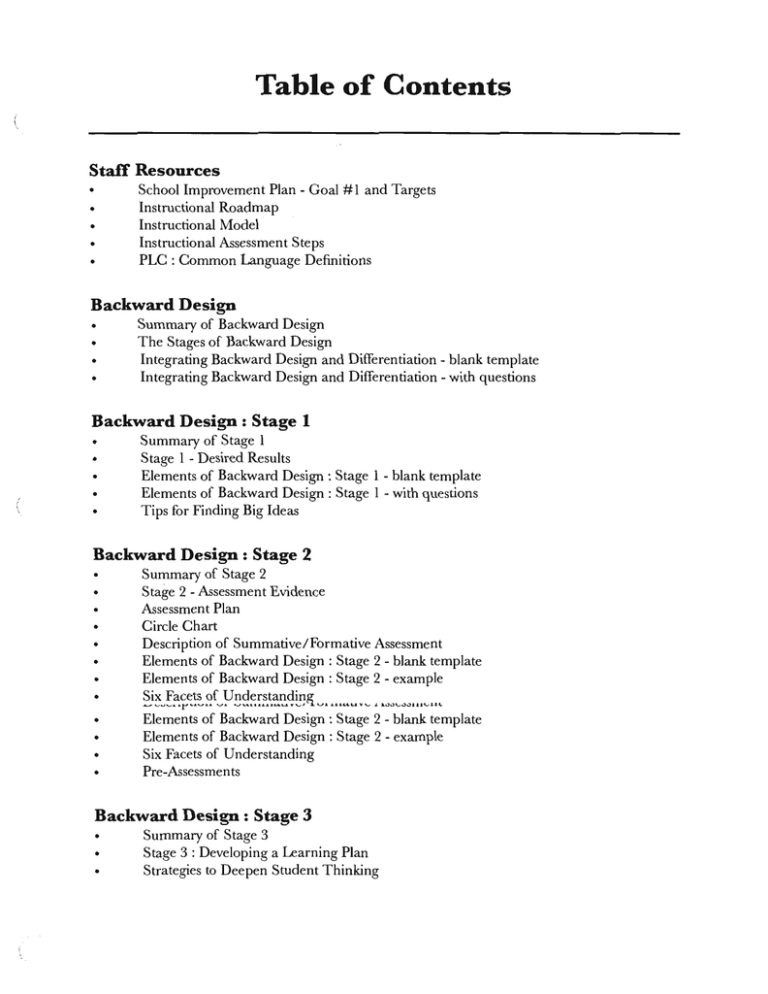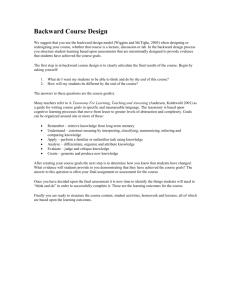Table of Contents Staff Resources
advertisement

Table of Contents Staff Resources • • • • • School Improvement Plan - Goal #1 and Targets Instructional Roadmap Instructional Model . Instructional Assessment Steps PLC : Common Language Definitions Backward Design • • • • Summary of Backward Design The Stages of Backward Design Integrating Backward Design and Differentiation - blank template Integrating Backward Design and Differentiation - with questions Backward Design: Stage 1 • • • • • Summary of Stage 1 Stage 1 - Desired Results Elements of Backward Design: Stage 1 - blank template Elements of Backward Design: Stage 1 - with questions Tips for Finding Big Ideas Backward Design: Stage 2 • • • • • • • • • • • • Summary of Stage 2 Stage 2 - Assessment Evidence Assessment Plan Circle Chart Description of Summative/Formative Assessment Elements of Backward Design: Stage 2 - blank template Elements of Backward Design: Stage 2 - example ~i~~~~~~~.<?f~pE~~::.t.':.~~~~~~ ...... ~ ''''''.,,'''III~II< u. • Elements of Backward Design: Stage 2 - blank template Elements of Backward Design: Stage 2 - example Six Facets of Understanding Pre-Assessmen ts Backward Design: Stage 3 • • • Summary of Stage 3 Stage 3 : Developing a Learning Plan Strategies to Deepen Student Thinking Data • • • School-wide OAKS data AYP Progress CFG Protocols • Atlas - looking at data • Data Driven Dialogue • Learning from Student Work • Student Work Gallery • Writing Workshop Feedback Protocol • What? So What? Now What? Assessmnentltesources • Assessment Literacy Strategies for Differentiated Instruction • • iWrite - iWrite rules part I and II Think Dots • • • • • • Grading Practices Goal #1 - School Improvement Plan Through shared targets and essential learnings, teachers will assess student knowledge, differentiate instruction to meet the needs of each student, monitor student progress through learning activities and common formative assessments, and then re-teach critical information and skills when needed. Targets: • Professional Learning Communities designate essential learnings for each trimester. • Essential learnings are the focal point of unit planning. • Assessment plan includes both formative and summative assessments. Pre-assessments are given prior to unit planning. Students are asked to apply knowledge and skill through the use of a . given prior to unit planning. Students are asked to apply knowledge and skill through the use of a performance task. ~ • Professional Learning Communities collect and analyze student data to inform future instruction. • Teachers plan for differentiated instruction monitor, reflect and adjust when needed. Instructional Roadmap State Standards Revised Instruction-Assessment Model with Data Analysis Pre-Assess Post-Assess COmmon Formative Assessments. Larry Ainsworth and Donald Viegut Instructional Assessment Steps 1. IdentifY the particular Essential Learnings in anyone content area for an upcoming unit of study. 2. IdentifY big ideas, transferable concepts, as well as knowledge and skills. 3. Write Essential Questions matched to the Big Ideas to focus instruction for teachers and to forecast learning goals for students. 4. Review the various types and formats of assessments available. 5. Select the assessment type or types that will provide the most credible evidence that students have learned the concepts and skills. 6. Create the pre- and post-assessment items for the particular assessment type(s). See Assessment Literacy section of ToolKit. 7. Administer pre-assessment to students; score and analyze results. 8. Reference the pre-assessment results; plan differentiated instruction, daily lessons, and learning activities needed for students to learn the concepts and skills and to express the Big Ideas in their own words. 9. Teach the unit, assess periodically, and use differentiated instructional strategies to meet individual learning needs. 10. Administer post-assessment to students; score and analyze results with PLC members. 10. Administer post-assessment to students; score and analyze results with PLC members. Common FormatWe Assessments, Ainsworth and Vzegut Professional Learnin Communities: Common Lan An approach to designing a curriculum or unit that begins with the end in mind and designs toward that end. Detennine Desired Results ------- Create Assessments --- Create a Learning Plan Understanding by Design, Wiggins and McTighe Incorporating instructional practices that maximize engagement and learning by meeting the needs of each student. An assessment created collaboratively by a team of teachers responsible for the same grade level or course. Learning by Doing, pg. 214 Formative Assessment: 11£or learning" Formative common assessments are used to determine what the student has learned at a specific point in time in order to inform the teacher of specific areas that need to be taught again or addressed in a new fonnat. LA Alignment Summative Assessment: 110£ leamingn Summative common assessments of learning are used to detennine the material the student has learned at a specific point in time. These are often used as gatekeepers, grade determiners, and or accountability measures. LA Alignment Ute practice of creating lessons that accommodate different students in a single classroom. A classroom may have students with a wide range of abilities and rather than "teach to the middle/' thereby losing the students who need extra help as well as those who need little repetition. a teacher may alter lessons so that all students in a classroom will benefit. The specific inferences, based on big ideas, that have lasting value beyond the classroom. Understanding by Design, Wiggins and McTighe Professional Leamin Communities: Common Lan A set of learning standards detennined by a PLe for each course, grade level and unit of instruction to which each student is held accountable for demonstrating proficiency. Essential learnings define priorities for instruction and assessment, and are detennined as being fundamental for student understanding and transferable to success in schooling, life or high-states assessments. Essential learnings cannot be differentiated. Essential learnings are big ideas and conceptual understandings for unit planning that are being developed through daily instruction. Essential learnings give the content meaning and connect the facts and skills. A question that lies at the heart of a subject or a curriculum (as opposed to being either trivial or leading), and promotes inquiry and uncoverage of a subject. Understanding by Design, Wiggins and McTighe The rules of behavior that are part of the ideology of the group. Norms tend to reflect the values of the group and specify those actions that are proper and those that are inappropriate. A task that uses one's knowledge to effectively act or bring to fruition a complex product that reveals one's knowledge and expertise. Understanding !nI Design, Wiggins and McTighe A formula for sheltered instruction that promotes the Ianguage I content development of learners. Professional Leami Communities: Common Strategical and Specific Measurable Attainable Results-oriented Timebound The state's set of learning standards defined by grade level or clusters of grades.


